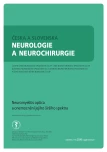Magnetic resonance imaging in neuromyelitis optica spectrum disorders
Authors:
M. Vaněčková
Authors‘ workplace:
Oddělení MR, Radiodiagnostická klinika 1. LF UK a VFN v Praze
Published in:
Cesk Slov Neurol N 2020; 83/116(supplementum 1): 20-30
doi:
https://doi.org/10.14735/amcsnn2020S20
Overview
Neuromyelitis optica is an autoimmune disease of unknown etiology characterized by primary involvement of the optic nerves and spinal cord. Unlike in MS, astrocytes are primarily affected. Lesions on MRI are mainly located in areas where aquaporin-4 is overexpressed. Lesions can be found in diencephalon periependymally around the lateral ventricles or fourth ventricle and in the corpus callosum. Pyramidal pathway involvement may also be seen but it is not associated with increased aquaporin-4 expression. Intramedullary involvement is most frequent in the form of longitudinal extensive transverse myelitis, where the lesion extends over three or more vertebral bodies. These lesions primarily affect the gray matter, often extend into periphery and occupy more than 50% of the spinal cord area in transverse cuts. Optic nerve involvement is typically bilateral in the dorsal part, also affecting the chiasma.
Sources
1. Wingerchuk DM, Weinshenker BG. Neuromyelitis optica. Clinical predictors of a relapsing coure and survival. Neurology 2003; 60 (5): 848–853. doi: 10.1212/01.wnl.0000049912.02954.2c.
2. Vaněčková M, Seidl Z. Roztroušená sklerózy a onemocnění bílé hmoty v MR zobrazení. Praha: Mladá fronta 2018 : 286.
3. Wingerchuk DM, Lennon VA, Pittock SJ et al. Revise diagnostic criteria for neuromyelitis optica. Neurology 2006; 66 (10): 1485–1489. doi: 10.1212/01.wnl.0000216139.44259.74.
4. Wingerchuk DM, Banwell B, Cabre P et al. International consensus diagnostic criteria for neuromyelitis optica spectrum disorders. Neurology 2015; 85 (2): 177–189. doi: 10.1212/WNL.0000000000001729.
5. Wang KY, Chetta J, Bains P et al. Spectrum of MRI brain lesion patterns in neuromyelitis optica spectrum disorder: a pictorial review. Br J Radiol 2018; 91 (1086): 20170690. doi: 10.1259/bjr.20170690.
6. Kim HJ, Paul F, Lana-Peixoto MA et al. MRI characteristics of neuromyelitis optica spectrum disorder. Neurology 2015; 84 (11): 1165–1173. doi: 10.1212/WNL.0000000000001367.
7. Huh SY, Min JH, Kim W el al. The usefelness of brain MRI at onset in the defferentiation of multiple sclerosis and seropositive neuromyelitis optica spektrum disorders. Mult Scler 2014; 20 (6): 695–704. doi: 10.1177/1352 58513506953.
8. Dutra BG, Rocha AJ, Nunes RH et al. Neuromyelitis optica spectrum disorders: spectrum of MR imaging findings and their differential diagnosis. RadioGraphics 2018; 38 (1): 169–193. doi: 10.1148/rg.2018170141.
9. Pekcevik Y, Orman G, Lee IH et al. What do we known about brain contrast enhancement patterns in neuromyelitis optica? Clin Imaging 2016; 40 (3): 573–580. doi: 10.1016/j.clinimag.2015.07.027.
10. Vaněčková M, Horáková D, Havrdová E et al. Retrospektivní studie nálezů na magnetické rezonanci míchy a mozku u pacientů s diagnózou neuromyelitis optica. Cesk Slov Neurol N 2010; 73/106 (2): 164–168.
11. Jauris S, Paul F, Franciotta D. Mechanisms of disease: aquaporin-4 antibodies in neuromyelitis optica. Nat Clin Pract Neurol 2008; 4 (4): 202–214. doi: 10.1038/nc pneuro0764.
12. Pekcevik Y, Mitchell CH, Mealy MA et al. Differentiating neuromyelitis optica from other causes of longitudinally extensive transverse myelitis on spinal magnetic resonance imaging. Mult Scler 2016; 22 (3): 302–311. doi: 10.1177/1352458515591069.
13. Huh SY, Kim SH, Hyun JW et al. Short segment myelitis as a first manifestation of neuromyelitis optica spectrum disorders. Mult Scler 2017; 23 (3): 413–419. doi: 10.1177/1352458516687043.
14. Flanagan EP, Weinshenker BG, Krecke KN et al. Short myelitis lesions in aquaporin-4.IgG-positive neuromyelitis optica spectrum disorders. JAMA Neurol 2015; 72 (1): 81–87. doi: 10.1001/jamaneurol.2014.2137.
15. Ramanathan S, Prelog K, Barnes EH et al. Radiological differention of optic neuritis with myelin oligodendrocyte glycoprotein antibodies, aquaporin-4 antibodies, and multiple sclerosis. Mult Scler J 2016; 22 (4): 470–482. doi: 10.1177/1352458515593406.
16. Wynford-Thomas R, Jacob A, Tomassini V. Neurological update: MOG antibody disease. J Neurol 2019; 266 (5): 1280–1286. doi: 10.1007/s00415-018-9122-2.
17. Deneve M, Biotti D, Patsoura S et al. MRI features of demyelinating disease associated with anti-MOG antibodies in adults. J Neuroradiol 2019; 46 (5): 312–318. doi: 10.1016/j.neurad.2019.06.001.
18. Jarius S, Ruprecht K, Kleiter I et al. MOG-IgG in NMO and related disorders: a multicenter study of 50 patients. Part1: fequency, syndrome specificity, influence of disease aktivity, long-term course, association with AQP4-IgG and origin. J Neuroinflammation 2016; 13 (1): 279. doi: 10.1186/s12974-016-0717-1.
19. Cobo-Calvo A, Ruiz A, Maillart E et al. Clinical spectrum and prognostic value of CNS MOG autoimunity in adults: the MOGADOR study. Neurology 2018 : 90 (21): e1858–e1869. doi: 10.1212/WNL.0000000000005560.
20. Ikeda A, Watanabe Y, Kaba H et al. MRI findings in pediatric neuromyelitis optica spectrum disorder with MOG antibody: four cases and review of the literature. Brain Dev 2019; 41 (4): 367–372. doi: 10.1016/j.braindev.2018.10.011.
21. Fernandez-Carbonell C, Vargas-LowyD, Musallam A et al. Clinical and MRI phenotype of children with MOG antibodies. Mult Scler 2016; 22 (2): 174–184. doi: 10.1177/1352458515587751.
22. Eichinger P, Schön S, Pongratz V et al. Accuracy of unenhanced MRI in the detection of new brain lesions in multiple sclerosis. Radiology 2019; 291 (2): 429–435. doi: 10.1148/radiol.2019181568.
23. Jurynczyk M, Tackley G, Kong Y et al. Brain lesion distribution criteria distinguish MS from AQP4-antibody NMOSD and MOG-antibody disease. J Neurol Neurosurg Psychiatry 2017; 88 (2): 132–136. doi: 10.1136/jnnp-2016-314005.
24. Duan Y, Liu Y, Liang P et al. Comparision of grey matter atrophy between patients with neuromyelitis optica and multiple sclerosis: a voxel-based morphometry study. Eur J Radiol 2012; 81 (2): e110–e114. doi: 10.1016/j.ejrad.2011.01.065.
Labels
Paediatric neurology Neurosurgery NeurologyArticle was published in
Czech and Slovak Neurology and Neurosurgery

2020 Issue supplementum 1
- Advances in the Treatment of Myasthenia Gravis on the Horizon
- Metamizole vs. Tramadol in Postoperative Analgesia
- Hope Awakens with Early Diagnosis of Parkinson's Disease Based on Skin Odor
Most read in this issue
- Magnetic resonance imaging in neuromyelitis optica spectrum disorders
- Neuromyelitis optica spectrum disorders – laboratory examination
- Epidemiology, clinical manifestation, and disease course of neuromyelitis optica spectrum disorders
- Differential diagnosis of neuromyelitis optica spectrum disorders
